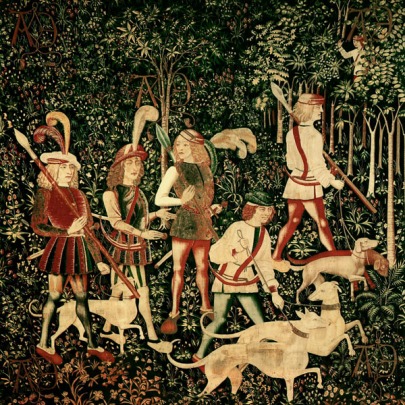


The unicorn tapestries are a set of 7 tapestries which are believed to have been made in the Netherlands between the years 1495 and 1505. The purpose of the tapestries is debated, but is popularly believed to be a wedding gift commissioned for the marriage between Anne of Brittany and Louis XII, King of France.
After several centuries of belonging to the La Rochefoucauld family; the tapestries were looted during the Frech revolution (spared from being destroyed because they did not show signs of royalty). The tapestries were found years later in the possession of peasants, who were using the 'old curtains' to cover potatoes and espalier trees to to stop them from freezing. The tapestries were painstaking restored after the damaged caused to them through poor treatment and now hang in the The Cloisters museum in New York.
The tapestries tell the story of the capture of a unicorn. The hunters eneter the woods, find the unicorn purifying water for animals by a fountain. The hunters attack the unicorn, but it defends itself. The unicorn is eventually captured after being charmed by a maiden, is killed and the body presented to a Lord and a lady at a castle. In the final tapestry, the unicorn has been revived and kneels
The tapestries tell the story of the capture of a unicorn. The hunters eneter the woods, find the unicorn purifying water for animals by a fountain. The hunters attack the unicorn, but it defends itself. The unicorn is eventually captured after being charmed by a maiden, is killed and the body presented to a Lord and a lady at a castle. In the final tapestry, the unicorn has been revived and kneels
captive in a small enclosure, looking contented, under a pomegranate tree from which juice from the red fruit drips over it's body.
The tapestries are made lush with rich flora, up to 80% of which are identifiable. The flora has been selected for it's special properties in medieval lore, to instil prosperity to the newlyweds. For example, periwinkles were believed to create unity between married couples, wallflowers to make a woman fertile and sweet violets to ward of wicked spirits.
The tapestries are overrun with pagan and Christian symbolism. The Unicorn has long been believed to be symbolic of christ. This is true of the tapestries, as many links can be made between the unicorn and stories of christ from the bible. The unicorn can only be tamed by a maiden, commenting on christs relationship with the Virgin Mary. The unicorn is shown with goldfinches at the fountain, a bird that was consider holy because it ate the torns of plants, relating to the crow of thorns worn by jesus before his execution.The Unicorns revival in the final tapestry also relates back to christs resurrection.
The tapestries compositions are busy and engaging. The focal point in all but the first tapestry is the unicorn; pale and splendid against the rich jewel-like colours of the rest of the hanging. The party of hunters frame the unicorn with their red and blue finery, their spears and the faces of the animals all reach toward the unicorn, further directing our eyes to the enchanted beast.
The tapestries are made lush with rich flora, up to 80% of which are identifiable. The flora has been selected for it's special properties in medieval lore, to instil prosperity to the newlyweds. For example, periwinkles were believed to create unity between married couples, wallflowers to make a woman fertile and sweet violets to ward of wicked spirits.
The tapestries are overrun with pagan and Christian symbolism. The Unicorn has long been believed to be symbolic of christ. This is true of the tapestries, as many links can be made between the unicorn and stories of christ from the bible. The unicorn can only be tamed by a maiden, commenting on christs relationship with the Virgin Mary. The unicorn is shown with goldfinches at the fountain, a bird that was consider holy because it ate the torns of plants, relating to the crow of thorns worn by jesus before his execution.The Unicorns revival in the final tapestry also relates back to christs resurrection.
The tapestries compositions are busy and engaging. The focal point in all but the first tapestry is the unicorn; pale and splendid against the rich jewel-like colours of the rest of the hanging. The party of hunters frame the unicorn with their red and blue finery, their spears and the faces of the animals all reach toward the unicorn, further directing our eyes to the enchanted beast.
No comments:
Post a Comment